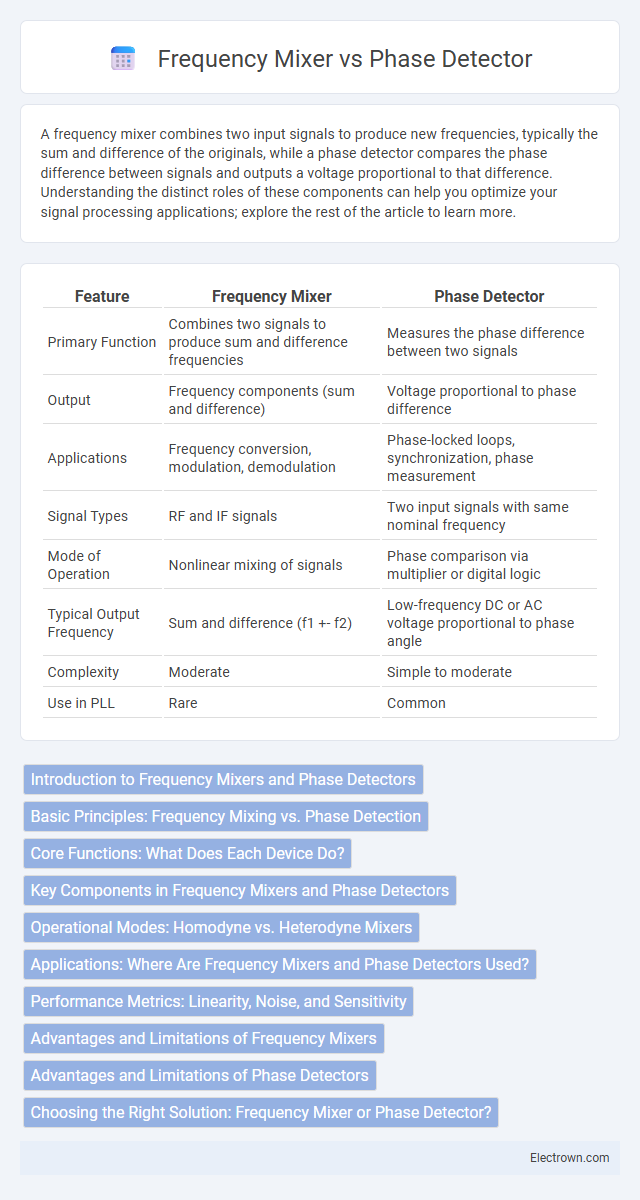A frequency mixer combines two input signals to produce new frequencies, typically the sum and difference of the originals, while a phase detector compares the phase difference between signals and outputs a voltage proportional to that difference. Understanding the distinct roles of these components can help you optimize your signal processing applications; explore the rest of the article to learn more.
Table of Comparison
| Feature | Frequency Mixer | Phase Detector |
|---|---|---|
| Primary Function | Combines two signals to produce sum and difference frequencies | Measures the phase difference between two signals |
| Output | Frequency components (sum and difference) | Voltage proportional to phase difference |
| Applications | Frequency conversion, modulation, demodulation | Phase-locked loops, synchronization, phase measurement |
| Signal Types | RF and IF signals | Two input signals with same nominal frequency |
| Mode of Operation | Nonlinear mixing of signals | Phase comparison via multiplier or digital logic |
| Typical Output Frequency | Sum and difference (f1 +- f2) | Low-frequency DC or AC voltage proportional to phase angle |
| Complexity | Moderate | Simple to moderate |
| Use in PLL | Rare | Common |
Introduction to Frequency Mixers and Phase Detectors
Frequency mixers and phase detectors are crucial components in radio frequency and communication systems, each serving distinct purposes; frequency mixers combine two input signals to produce new frequencies through sum and difference results, enabling frequency translation and modulation. Phase detectors, on the other hand, compare the phase difference between two signals, generating a voltage that reflects this difference, which is essential for phase-locked loops and synchronization tasks. Understanding the operational principles of both devices allows you to optimize signal processing and frequency control in various electronic applications.
Basic Principles: Frequency Mixing vs. Phase Detection
Frequency mixers combine two input signals to produce new frequencies equal to the sum and difference of the original frequencies, enabling frequency translation in communication systems. Phase detectors compare the phase difference between two signals, generating an output proportional to that difference, commonly used in phase-locked loops for synchronization. While frequency mixers manipulate signal frequencies, phase detectors measure phase alignment, serving distinct roles in signal processing and modulation.
Core Functions: What Does Each Device Do?
A frequency mixer combines two input signals to produce new frequencies equal to the sum and difference of the original frequencies, enabling frequency translation in communication systems. A phase detector compares the phase difference between two input signals and outputs a voltage proportional to that difference, essential for phase-locked loops and synchronization applications. While frequency mixers primarily perform frequency conversion, phase detectors provide critical phase error information for frequency control and signal alignment.
Key Components in Frequency Mixers and Phase Detectors
Frequency mixers primarily consist of non-linear components such as diodes or transistors that facilitate the multiplication of input signals to produce sum and difference frequencies. Phase detectors include elements like flip-flops, XOR gates, or multiplier circuits designed to compare the phase difference between two input signals, outputting a voltage proportional to that difference. Understanding these key components can help you choose the right device for signal processing tasks involving frequency conversion or phase comparison.
Operational Modes: Homodyne vs. Heterodyne Mixers
Frequency mixers operate in heterodyne mode by combining two different input frequencies to produce sum and difference frequencies, enabling frequency translation in communication systems. Phase detectors commonly function in homodyne mode, comparing the phase difference between two signals at the same frequency to extract phase information for synchronization and demodulation. Heterodyne mixers enable broad frequency shifts crucial for RF front-end architectures, while homodyne phase detectors are essential in phase-locked loops and coherent demodulation tasks.
Applications: Where Are Frequency Mixers and Phase Detectors Used?
Frequency mixers are widely used in communication systems for frequency translation, enabling signal modulation and demodulation in radios, satellite transceivers, and radar equipment. Phase detectors play a crucial role in phase-locked loops (PLLs) for synchronization, clock recovery, and frequency synthesis in applications like telecommunications and digital signal processing. Your choice between these components depends on whether you need frequency conversion or precise phase comparison in your electronic system.
Performance Metrics: Linearity, Noise, and Sensitivity
Frequency mixers exhibit superior linearity, allowing accurate conversion of input signals across a wide dynamic range, essential for maintaining signal integrity. Phase detectors, while highly sensitive to phase variations, may introduce more noise, affecting overall system precision in low-SNR environments. Your choice depends on prioritizing linearity and noise performance for frequency translation or sensitivity for phase measurement within your application.
Advantages and Limitations of Frequency Mixers
Frequency mixers offer high-frequency signal conversion with broad bandwidth and efficient linearity, making them ideal for modulation, demodulation, and frequency synthesis applications. Their limitations include potential signal distortion and intermodulation products, requiring careful filter design to minimize unwanted harmonics. You benefit from their versatility in RF systems, but must manage noise figure and conversion loss for optimal performance.
Advantages and Limitations of Phase Detectors
Phase detectors offer precise measurement of phase differences in signals, making them essential for phase-locked loops and synchronization tasks. They provide high sensitivity and linearity within a limited phase range but can suffer from phase ambiguity and limited dynamic range. Your choice depends on whether timing accuracy (phase detector) or frequency translation (frequency mixer) is prioritized in your application.
Choosing the Right Solution: Frequency Mixer or Phase Detector?
Choosing between a frequency mixer and phase detector depends on the application requirements such as signal type, frequency range, and desired output. Frequency mixers convert input signals to new frequencies through multiplication, ideal for frequency translation and modulation tasks in RF systems. Phase detectors measure phase difference between signals, essential for phase-locked loops and synchronization in communication systems.
frequency mixer vs phase detector Infographic

 electrown.com
electrown.com